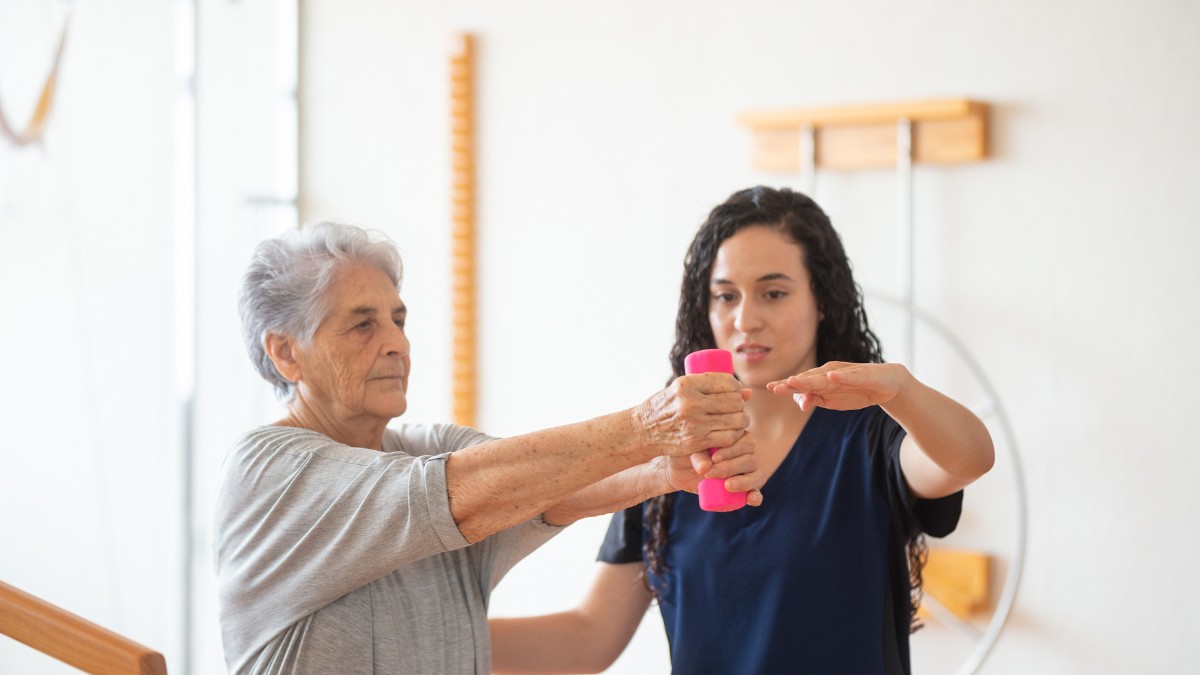Key Points:
- In-home physical therapy offers convenience, comfort, and continuity of care for patients with mobility challenges or chronic conditions.
- Home-based sessions provide personalized attention and exercises tailored to your living environment and daily routines.
- Physical therapy at home helps reduce fall risk, improve strength, and promote recovery, without the stress of travel.
Physical therapy is crucial for regaining mobility and easing discomfort when recuperating from an injury or surgery, or managing a chronic condition. However, for many, traveling to a clinic can present challenges, proving to be arduous, exhausting, or even risky.
This is precisely why receiving physical therapy in the familiar surroundings of your home can make all the difference. If you or someone you care about is considering this approach, you’re likely curious about what to expect and how it can support your recovery or long-term health objectives.
This article will delve into the numerous benefits of home-based physical therapy, especially for individuals seeking effective treatment without having to leave their residence. Whether you’re facing limited movement, persistent fatigue, or simply prefer the comfort of your own space, this guide is designed to assist you.

What Is In-Home Physical Therapy?
In-home physical therapy is when a licensed physical therapist visits you at your home to provide personalized treatment and support. Just like in a clinic, the therapist evaluates your condition and develops a plan to help restore strength, balance, mobility, and function.
The main difference? You receive care without having to leave your living room, climb stairs, or wait in a busy office.
It’s especially helpful for older adults, people recovering from surgery or illness, and those with disabilities who find travel challenging. It’s also ideal for those who want to build strength in the same environment where they live day-to-day.
Why Choose Physical Therapy at Home?
Physical therapy at home addresses many of the barriers people face when trying to follow through with traditional clinic appointments. Here’s how it makes life easier—and recovery more manageable.
1. Convenience That Supports Consistency
Getting to a clinic multiple times a week can be physically and emotionally draining, especially when dealing with pain, weakness, or fatigue. Transportation challenges, bad weather, or a tight schedule can lead to missed appointments.
By bringing therapy to your door, you eliminate those obstacles. Sessions happen in your own time and space, making it easier to stick with the program and see results.
2. Personalized Attention in a Familiar Setting
In-home therapists can design exercises specifically suited to your space—your stairs, your hallway, your chair. They can see how you move in your natural environment and tailor the therapy to your actual daily life.
This level of personalization often leads to better outcomes because the treatment is directly relevant to how you live.
3. Increased Comfort and Reduced Anxiety
Some people feel self-conscious or overwhelmed in a busy therapy clinic. Others simply find it more relaxing to be in their own home, surrounded by familiar things.
This comfort can lead to better focus, improved motivation, and a more positive attitude toward the healing process.

Key Benefits of Receiving Physical Therapy in the Comfort of Home
Let’s take a deeper look at the specific benefits that home-based therapy can offer across physical, emotional, and practical dimensions.
Improved Safety and Fall Prevention
One major goal of physical therapy is reducing the risk of falls and injuries, especially for older adults. At home, a therapist can:
- Assess potential fall hazards like rugs, clutter, or stairs
- Teach balance and coordination exercises in real-time, in the actual environment
- Recommend simple home modifications to prevent accidents
This level of hands-on, in-context prevention simply isn’t possible in a clinic.
Better Recovery After Surgery or Illness
After surgeries such as joint replacements or hospital stays due to illness, energy levels are often low. Home-based therapy ensures recovery begins promptly without the strain of traveling.
Therapists can help restore range of motion, reduce swelling, and build strength—all within the safety of the home.
Enhanced Independence
For those living with chronic conditions like Parkinson’s disease, arthritis, or stroke-related impairments, therapy at home supports the goal of maintaining independence.
With time, therapy can:
- Improve muscle function
- Support walking and daily movement
- Reduce reliance on caregivers or assistive devices
- Boost confidence in performing everyday tasks
Emotional Relief for Families and Caregivers
When therapy happens at home, family members can observe, participate, and learn. This helps them understand the patient’s needs better and feel more confident in offering support.
It also relieves the stress of transportation and coordination, making life easier for the entire household.
Who Benefits Most From In-Home Physical Therapy?
While almost anyone can enjoy the convenience of therapy at home, certain groups benefit especially:
- Seniors with mobility limitations or fall risks
- Post-surgical patients recovering from hip, knee, or spine procedures
- Stroke survivors working to regain function
- People with chronic illnesses like multiple sclerosis, arthritis, or Parkinson’s
- Individuals with transportation barriers due to disability or lack of access
If any of these scenarios sound familiar, in-home therapy might be the most practical and effective path forward.
What to Expect From Your First Home Therapy Visit
Starting physical therapy at home is often easier than people expect. Here’s what typically happens:
Initial Evaluation
Your physical therapist will assess your medical history, current abilities, and home environment. They may ask about pain levels, goals, and challenges with daily activities.
Goal-Setting and Care Plan
Together, you’ll set achievable goals—like walking without assistance, getting in and out of bed more easily, or climbing stairs. The therapist will create a care plan with exercises tailored to your needs.
Regular Sessions
Ongoing sessions may focus on strength training, stretching, balance work, mobility, or pain relief techniques. Progress is tracked and adjustments are made as needed.
Education and Home Exercise
Your therapist will often assign light exercises to do between sessions and teach safe ways to move around your home.
This approach encourages steady progress and puts you at the center of your recovery.
Tips to Maximize Your At-Home Therapy Experience
To get the most from physical therapy at home, consider these practical tips:
- Create a clear space for exercises, free from clutter
- Wear comfortable clothing that allows movement
- Communicate openly with your therapist about pain, progress, or concerns
- Stick to your routine and follow through on any at-home exercises
- Involve a caregiver or family member if you need support or encouragement
Consistency and communication are key to building momentum and seeing results.
Experience In-Home Physical Therapy in New York
If you’re ready to explore a more convenient, personalized approach to recovery, Revival Home Health Care provides expert in-home physical therapy in New York.
Our certified therapists bring top-notch care directly to you, customizing treatment to fit your living situation, personal requirements, and aspirations. Whether you’re bouncing back from an operation, handling a long-term illness, or aiming to become more self-sufficient, our professionals are ready to assist you—all in the comfort of your own home.
Reach out today to learn how our in-home physical therapy services can help you move better, feel stronger, and live with more confidence—all from the comfort of home.


 75 Vanderbilt Ave Staten Island, NY 10304
75 Vanderbilt Ave Staten Island, NY 10304 info@revivalhhc.org
info@revivalhhc.org 718.629.1000
718.629.1000